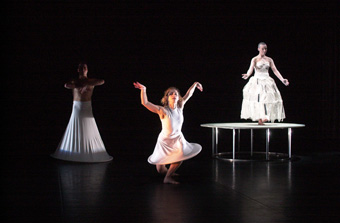The light between
Sue Moss: TasDance; Parrott's Swimming the Luna Sea, Liedkte's Enter Twilight

Tasdance, Light and Dark
photo Paul Scambler
Tasdance, Light and Dark
Light and Shade explores the boundaries, spaces and possibilities of darkness and light, blurring the notion that light is pure while darkness is a menacing force devoid of innocence. Conceived and curated by TasDance’s artistic director Annie Grieg, the show comprises Swimming the Luna Sea by Chrissie Parrott and Tanya Liedtke’s Enter Twilight.
In the opening sequence of Luna Sea, entitled “Dark”, Parrott situates 3 male and 3 female dancers in a stark and shattered landscape. Jonathon Mustard’s sound score of rainfall, howling dogs and the relentless creak of timber enhances the sense of unease and loss. Accomplices and competitors in an alien place, the dancers move between corporeal claim and counter claim of initial touch and support, to the squared-off angular movements of threat and abandonment.
In this space of lunar dispossession the ensemble (re)enact the frisson and fragility which co-exist in the habitual province of human encounter, potential and rejection. Theresa O’Connor’s lighting design has a precursor in the hoary light we associate with the first moon landing. The semi-dark state enhances both the group’s isolation and their body motifs: the recurring minutiae of a dancer’s clawed hand, a finger flick, an inverted foot, a jagged hip.
A stone rolls from one cheek to another, momentarily counter-pointing the alienation of place and space. Words have yet to assume the shape and potency of meaning. Consonant and vowel provide an aural ostinato, as sound stumbles on the tongue and splits around the mind’s incomprehension. Each dancer’s physical vocabulary moves between recall of lost humanness juxtaposed against the whip-strength and aggression of a non-human state. They move from acquiescence to a dominance of each other while remaining submissive to the hiss and whisper of a landscape before language.
The apprehensive mood shifts in “Light”, the second section of Luna Sea. Trisha Dunn appears as a White Dew figure draped in a silver gown and shedding astral dust. This figure of innocence and immanence offers declamatory gestures. She mouths half-realised sounds suggestive of a seer uttering fragments of language, which allay the sense of estrangement and terror.
Three bare-chested male dancers glide in white-hooped skirts like retainers in an imagined Tutankhamen court. They present an image of beauty and quirkiness as the dancers’ weighted skirts swing and wrap their bodies. When pulled over the head, the skirt accentuates the dancer’s facial structure through a taut cloth mask. Moving like wraiths in space, Craig Bary, Ryan Lowe and Malcolm McMillan offer gestural homage to White Dew as they mirror her hand motifs. This provides an enlivened and illumined resolution after uncertainty and darkness.
Tanja Liedtke is a choreographer who re-imagines the parameters and possibilities of dance. Her choreographic finesse in Enter Twilight explores the paradox that exists within life’s rituals through the allure, seduction, playfulness and danger enacted between a male and 3 female dancers.
Craig Bary sleeps on stage while 3 young women—Trisha Dunn, Lisa Griffiths and Tania Tabacchi—observe, chat and speculate. Liedtke knows how to set her dancers on a trajectory that makes deft and detailed use of the body. The performers split and navigate space, generating a simultaneous allure and frisson of excitement. They reveal the paradox of dangerous states teetering between humour, innocence and treacherousness.
This dance is stylish, pert, cheeky and flirtatious. Each girl targets, then engages in an alternately naïve, groovy and sensuous dance conversation with the boy/man. The dancers whisper and tease, embarking across the terrain of taunt and threat implicit in relationships. Composer DJ Tr!p’s lo-fi electronic sound score projects the crack, scratch and pop of tired vinyl, the result of too frequent playing by kids making their moves on each other and the world. Seated dancers are intriguingly lit from beneath as they glide around a wooden bench in playfulness, entanglement and pursuit.
Liedtke’s strengths include inventiveness and visual surprise. In one sequence each dancer falls and rebounds from the floor as an agile unit of momentum. The reversed upward movement is like watching a film in slow motion replay. In another visually arresting moment, 3 pairs of inverted legs disconcertingly appear in space, luring the eye away from the site of action.
Swimming the Luna Sea and Enter Twilight use the languages of the body and the tongue to illuminate the territories of light and shade, seduction, corruption and desire.
TasDance, Swimming the Luna Sea, choreographer Chrissie Parrott, music Jonathon Mustard, lighting Theresa O’Connor, design Chrissie Parrott with Darren Willmott; Enter Twilight, choreographer Tanja Liedtke; music DJ Tr!p, design Tanja Liedtke with Darren Willmott; Hobart College Auditorium, May 6-9
RealTime issue #61 June-July 2004 pg. 49






